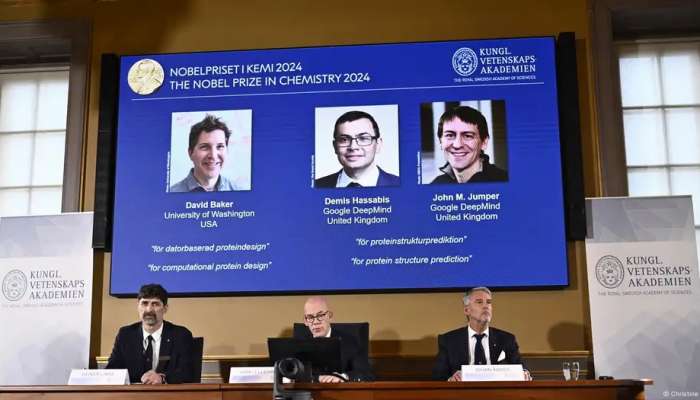
Stockholm: David Baker, Demis Hassabis and John M. Jumper have been awarded the Nobel Prize in Chemistry for their research into computational protein design and protein structure prediction.
"This research is a landmark moment, as it was considered impossible for years to predict the structures of proteins," said the Chair for the Nobel Committee for Chemistry, Heiner Linke, who also explained how proteins serve as building blocks of all bodily functions.
"I was sleeping when the phone rang. And my wife began screaming very loudly," Baker told reporters. "I stood on the shoulders of giants," he said, as he gave credit to his fellow researchers. "I love all the proteins, I cannot pick a favorite," he added.
Proteins and their structures — simply explained
Proteins are made-up of strings of amino acid molecules, which then form complex sequences. These sequences help read, copy and repair DNA. DNA, or deoxyribonucleic acid, is a molecule that contains the genetic code that is unique to every individual.
"These proteins consist of hundreds of thousands of atoms that are responsible for every biochemical function in the body," Linke said.AI helped crack the code
Avancements in artificial intelligence (AI) and machine learning, for which the 2024 Physics Nobel Prizes were awarded, also helped Baker, Hassabis and Jumper with their research.
Baker and his fellow laureates cracked the code of what protein structures may look like with the help of AI.
"They used neural networks and deep learning to train a database that then showed how close two amino acid structures were to each other in space," said Johan Aqvist, a member of the Nobel Committee for Chemistry.
From predicting protein structures to designing new ones
David Baker created computational tools to predict protein structures, building on the 1972 Chemistry Nobel Prize discoveries.
Those findings revealed the link between amino acid sequences and the way they fold into biologically active 3D protein structures.
Efforts to identify protein structures began in 2003 when Baker and his team created a computer program called Rosetta.
Combined with X-ray crystallography, a technique focused on uncovering atomic-level structures, Baker successfully predicted a protein structure that matched its actual form.
Before Baker could design new proteins, their real structures had to be predicted with high accuracy, which remained low until 2018.
This changed with AlphaFold, an AI tool developed by Demis Hassabis and John M. Jumper from DeepMind, a subsidiary of Alphabet. AlphaFold, a deep learning system, demonstrated that neural networks can model the complex process of protein folding.
AlphaFold 2 further improved accuracy by enhancing its internal representation and incorporating key structural knowledge into the model.
Thanks to the works of Hassabis and Jumper, protein structure predictions can now reach an accuracy of 90%, enabling Baker to design new protein structures.
A nasal spray that prevents viruses
His work, thanks to advancements in AI, is being used to engineer medications. Baker and his team have come up with a nasal spray which contains proteins designed specially to ward off most pandemic viruses, like the coronavirus.
Predicting and designing protein structures can aid in identifying enzymes that contribute to antibiotic resistance, while also helping to develop new vaccines and treatments.